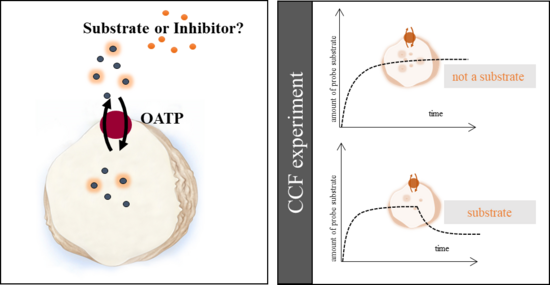Competitive counter-flow experiments as a method to screen for substrates of the Organic Anion Transporting Polypeptides (OATPs)
Competitive counterflow (CCF) experiments have successfully been applied to identify substrates of the organic cation transporter 2 (OCT2, https://www.ncbi.nlm.nih.gov/pubmed/23034939), it is aim of this project to test whether a similar approach can be used to identify substrates of organic anion transporting polypeptides.
In order to establish the method we used stably transfected MDCKII cells and a high affinity substrate of the transporter expressed. After optimizing the protocol to be applied for OATP2B1 (for details refer to [1]), we screened a library of molecules for their influence on the cellular amount of estrone 3-sulfate in the steady state equilibrium, and found multiple molecules to be transported. Importantly, all known substrates of OATP2B1 included in the library significantly reduced the amount of the probe substrate in the steady-state equilibrium [1]. After validating the applicability in other studies [2, 3], we have also optimized the method to be applied for OATP1A2 [4, 5].
In conclusion, CCF experiments are applicable to screen for substrates of OATP2B1 and of OATP1A2. However, we learned that the quality of the data highly depends on the amount of transporter expressed in the cellular system and on the availability of a high affinity substrate.
It is aim of future studies to extend the portfolio of transporters, where CCF experiments can be applied to screen for substrates. And to further extend the list of compounds tested for interaction.

[1] Establishment and validation of competitive counterflow as a method to detect substrates of the Organic Anion Transporting Polypeptide 2B1. Schäfer AM, Bock T, Meyer zu Schwabedissen HE. Mol Pharm. 2018 3; 15(12):5501-5513. doi: 10.1021/acs.molpharmaceut.8b00631. (https://www.ncbi.nlm.nih.gov/pubmed/30380886)
[2] Hyperforin-induced activation of the Pregnane X Receptor is influenced by the Organic Anion-Transporting Polypeptide 2B1. Schäfer AM, Potterat O, Seibert I, Fertig O, Meyer zu Schwabedissen HE. Mol Pharmacol. 2019; 95(3):313-323. doi: 10.1124/mol.118.114066. (https://www.ncbi.nlm.nih.gov/pubmed/30573512)
[3] Thyroid hormones are transport substrates and transcriptional regulators of Organic Anion Transporting Polypeptide 2B1. Meyer zu Schwabedissen HE, Ferreira C, Schaefer AM, Oufir M, Seibert I, Hamburger M, Tirona RG. Mol Pharmacol. 2018;94(1):700-712. doi: 10.1124/mol.117.111161. (https://www.ncbi.nlm.nih.gov/pubmed/29735582)
[4] OATP1A2 and OATP2B1 Are Interacting with Dopamine-Receptor Agonists and Antagonists. Schäfer AM, Meyer zu Schwabedissen HE, Bien-Möller S, Hubeny A, Vogelgesang S, Oswald S, Grube M. Mol Pharm. 2020 Jun 1;17(6):1987-1995. doi: 10.1021/acs.molpharmaceut.0c00159. (https://www.ncbi.nlm.nih.gov/pubmed/32343897)
[5] Constituents of Passiflora incarnata, but Not of Valeriana officinalis, Interact with the Organic Anion Transporting Polypeptides (OATP)2B1 and OATP1A2. Schäfer AM, Gilgen PM, Spirgi C, Potterat O, Meyer Zu Schwabedissen HE. Planta Med. 2021 Jan 28. doi: 10.1055/a-1305-3936 (https://pubmed.ncbi.nlm.nih.gov/33511622)
